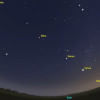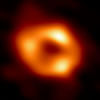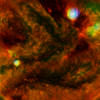18 billion solar mass black hole rotates at 1/3 speed of light

Far far away in the constellation Cancer there is a 14th magnitude speck of light one can claim in a 10-inch or larger telescope.
Essentially this tiny speck represents the final farewell of chewed up stars as their remains whirl down the throat of an 18 billion solar mass black hole, one of the largest known in the universe, reports Universe Today.
Astronomers recognise this object as OJ 287, a quasar that lies some 3.5 billion light years from Earth.
Quasi-stellar objects or Quasars light up the centers of many remote galaxies and if we could get a closer look, we would see a brilliant, flattened accretion disk composed of heated star-stuffing spinning about the central black hole at extreme speeds, reports Universe Today.
According to the news portal, as matter gets sucked down the hole, jets of hot plasma and energetic light shoot out perpendicular to the disk and if we're so privileged that one of those jet happens to point directly at us, we call the quasar a "blazar".
Variability of the light streaming from the heart of a blazar is so constant, the object practically flickers.
A recent observational campaign involving more than two dozen optical telescopes and NASA's space based SWIFT X-ray telescope allowed a team of astronomers to measure very accurately the rotational rate the black hole powering OJ 287 at one third the maximum spin rate — about 56,000 miles per second (90,000 kps) — allowed in General Relativity a careful analysis of these observations show that OJ 287 has produced close-to-periodic optical outbursts at intervals of approximately 12 years dating back to around 1891.
A close inspection of newer data sets reveals the presence of double-peaks in these outbursts.
OJ 287 is visible due to the streaming of matter present in the accretion disk onto the largest black hole. The smaller black hole passes through the larger's the accretion disk during its orbit, causing the disk material to briefly heat up to very high temperatures.
This heated material flows out from both sides of the accretion disk and radiates strongly for weeks, causing the double peak in brightness.
The orbit of the smaller black hole also precesses similar to how Mercury's orbit precesses. This changes when and where the smaller black hole passes through the accretion disk.
After carefully observing eight outbursts of the black hole, the team was able to determine not only the black holes' masses but also the precession rate of the orbit. Based on Valtonen's model, the team predicted a flare in late November 2015, and it happened right on schedule, reports Universe Today.
The timing of this bright outburst allowed Valtonen and his co-workers to directly measure the rotation rate of the more massive black hole to be nearly 1/3 the speed of light. I've checked around and as far as I can tell, this would make it the fastest spinning object we know of in the universe

 For all latest news, follow The Daily Star's Google News channel.
For all latest news, follow The Daily Star's Google News channel. 







Comments